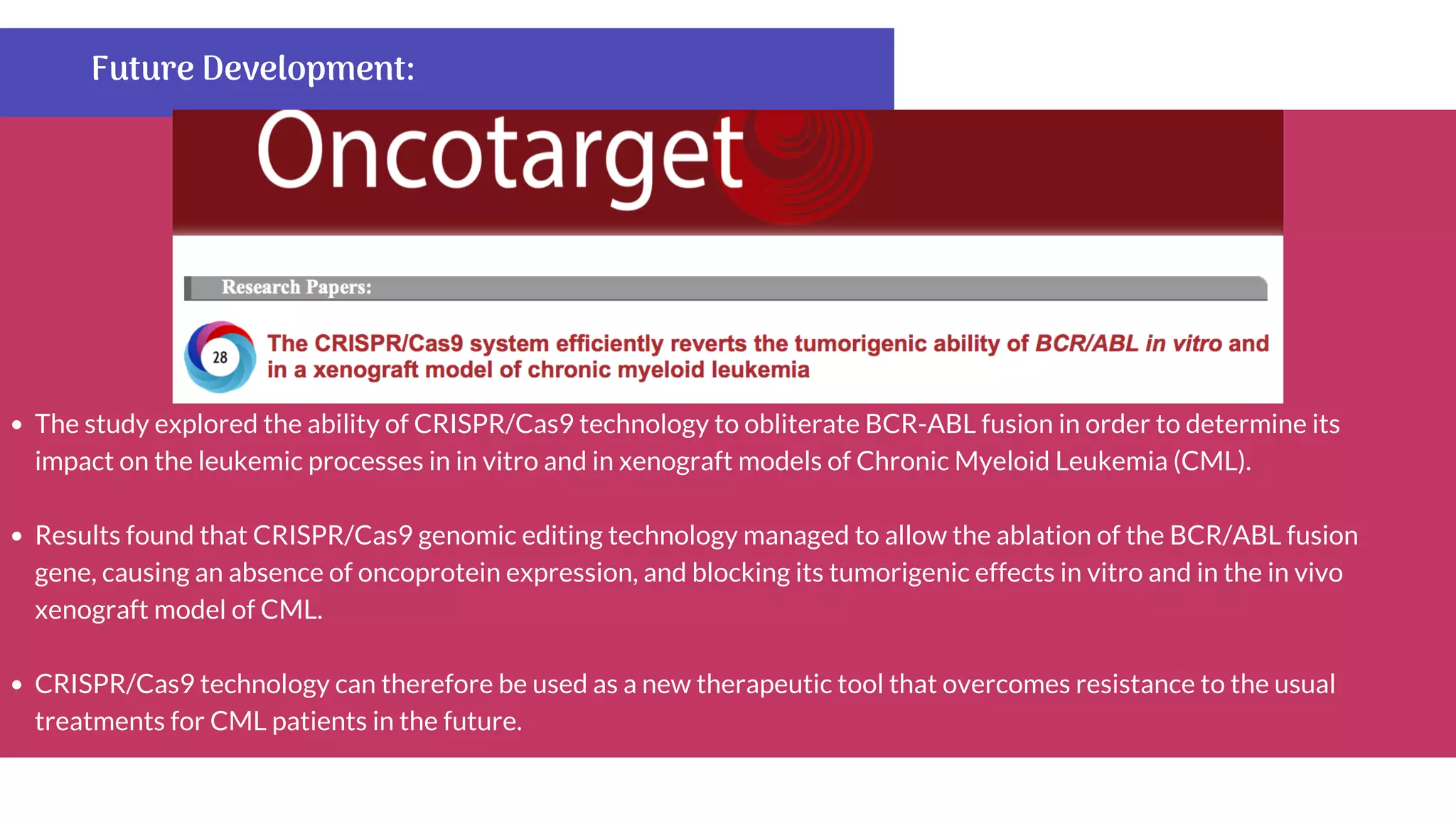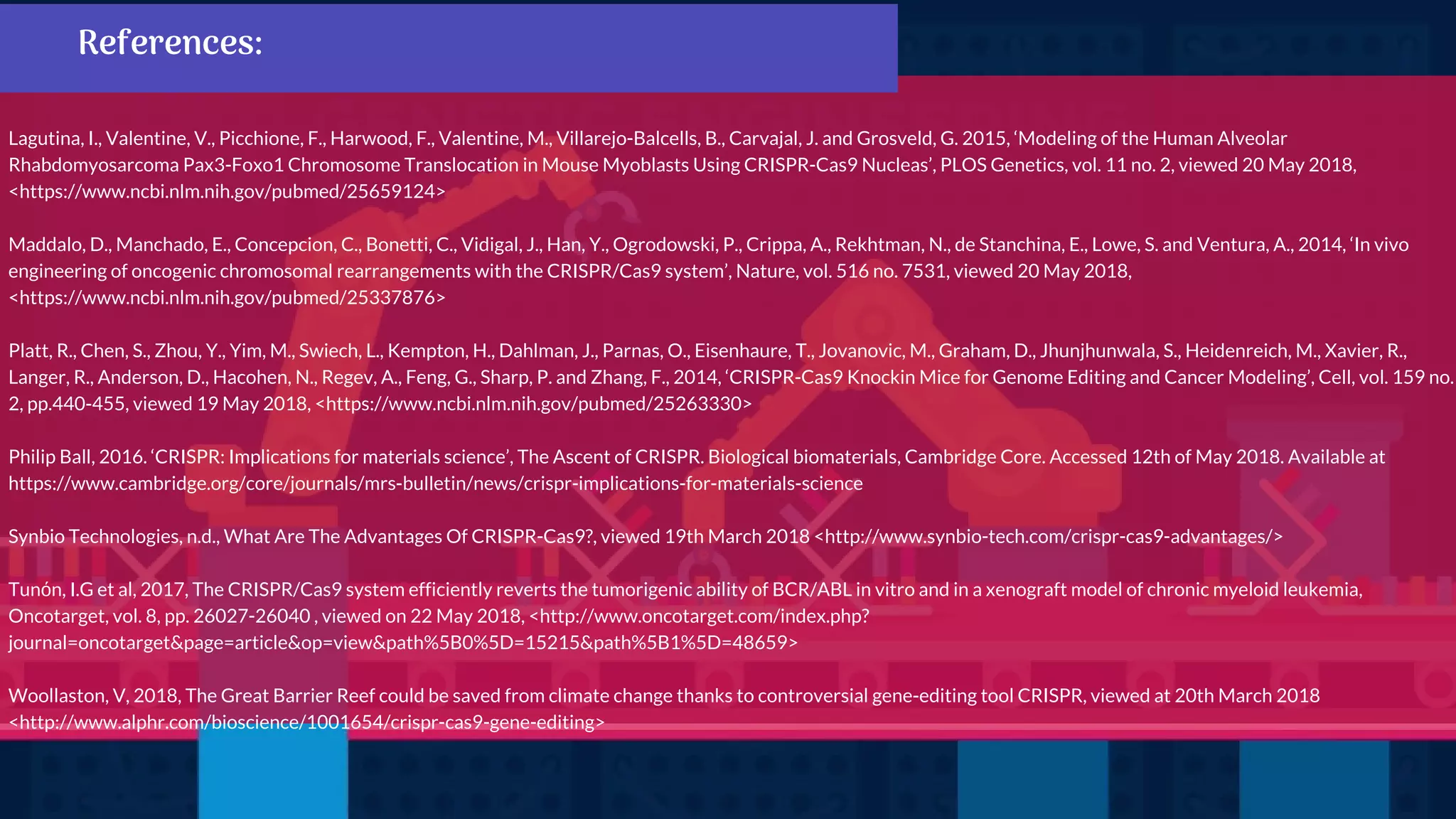The document discusses the applications of CRISPR-Cas9 gene editing technology in cancer therapy, emphasizing its potential to modify oncogenes and address genetic mutations driving cancer development. It details the mechanisms of CRISPR-Cas9, including its ability to make precise DNA alterations and the challenges it faces, such as off-target effects. Additionally, the document highlights the future prospects of CRISPR-Cas9 in treating various cancers, particularly those associated with viral oncogenes.















![References:
Feng Zhang, 2017. ‘Questions and Answers about CRISPR’ Broad Institute. Accessed 14th of May 2018. Available at: https://www.broadinstitute.org/what-broad/areas-
focus/project-spotlight/questions-and-answers-about-crispr
García-Tuñón, I., Hernández-Sánchez, M., Ordoñez, J., Alonso-Pérez, V., Álamo-Quijada, M., Benito, R., Guerrero, C., Hernández-Rivas, J. and Sánchez-Martín, M. 2017, The
CRISPR/Cas9 system efficiently reverts the tumorigenic ability of BCR/ABL in vitro and in a xenograft model of chronic myeloid leukemia, oncotraget, viewed 19 May 2018,
<http://www.oncotarget.com/index.php?journal=oncotarget&page=article&op=view&path%5B0%5D=15215&path%5B1%5D=48659>
Gilbert, L., Horlbeck, M., Adamson, B., Villalta, J., Chen, Y., Whitehead, E., Guimaraes, C., Panning, B., Ploegh, H., Bassik, M., Qi, L., Kampmann, M. and Weissman, J., 2014,
‘Genome-Scale CRISPR-Mediated Control of Gene Repression and Activation’, Cell, vol. 159 no. 3, pp.647-661, viewed 19 May 2018,
<https://www.ncbi.nlm.nih.gov/pmc/articles/PMC4253859/>
Kannan, K., Coarfa, C., Chao, P., Luo, L., Wang, Y., Brinegar, A., Hawkins, S., Milosavljevic, A., Matzuk, M. and Yen, L. 2015, ‘Recurrent BCAM-AKT2fusion gene leads to a
constitutively activated AKT2 fusion kinase in high-grade serous ovarian carcinoma’, Proceedings of the National Academy of Sciences, vol. 112 no. 11, viewed 20 May 2018,
<https://www.ncbi.nlm.nih.gov/pubmed/25733895>
Kawamura, N., Nimura, K., Nagano, H., Yamaguchi, S., Nonomura, N. and Kaneda, Y. 2015, ‘CRISPR/Cas9-mediated gene knockout of NANOG and NANOGP8 decreases the
malignant potential of prostate cancer cells’, Oncotarget, vol. 6, no. 26, viewed 19 May 2018, <http://www.oncotarget.com/index.php?
journal=oncotarget&page=article&op=view&path[]=4293&path[]=10990>
Lagutina, I., Valentine, V., Picchione, F., Harwood, F., Valentine, M., Villarejo-Balcells, B., Carvajal, J. and Grosveld, G. 2015, ‘Modeling of the Human Alveolar
Rhabdomyosarcoma Pax3-Foxo1 Chromosome Translocation in Mouse Myoblasts Using CRISPR-Cas9 Nucleas’, PLOS Genetics, vol. 11 no. 2, viewed 20 May 2018,
<https://www.ncbi.nlm.nih.gov/pubmed/25659124>
Kennedy, M.K et al. 2014, Inactivation of the Human Papillomavirus E6 or E7 Gene in cervical carcinoma cells by using a bacterial CRISPR/Cas RHNA-Guided Endonuclease,
Journal of Virology, vol. 88, no. 20, pp. 11965-11972, viewed on 21 May 2018, <http://jvi.asm.org/content/88/20/11965.short>](https://image.slidesharecdn.com/gtcpresentation-180523044100/75/Applications-of-Gene-Editing-CRISPR-Cas9-in-Cancer-Therapeutics-Oncogenes-16-2048.jpg)

